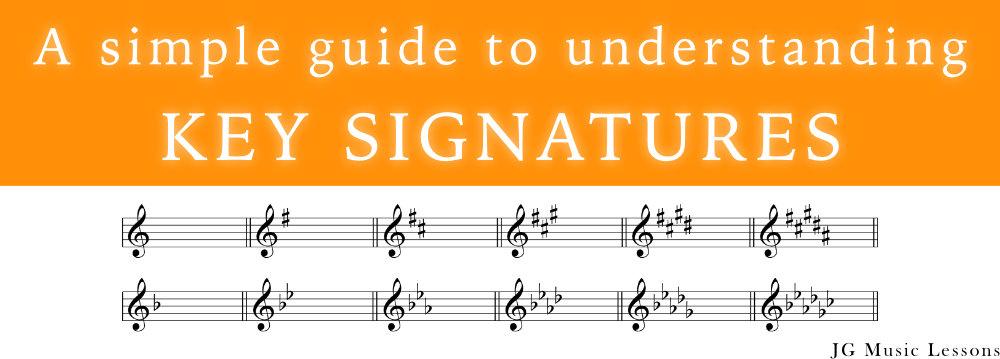Key signatures are one of the essential music symbols to know when reading notation. In this guide we’ll explain what key signatures are, how to learn the symbols in all keys using the circle of 5ths and quick tips to find your music keys.
You’ll also be able to test your knowledge with a key signature quiz at the end of this lesson. Let’s get started.
What is a key signature?
A key signature is a symbol used in music notation to define the tonality of a piece of music and indicate the notes in a scale. Each key signature has a different amount of accidentals (sharp or flat notes) that define its scale. Instead of having to write a sharp or flat note every time it comes up, you can define this change throughout a piece of music using a key signature.
For example, here is a melody in the key of Db without a key signature.

Now here is what the same notes in the previous example look like using a key signature.

As you can see, using a key signature results in a much cleaner and more efficient way to notate music.
Chart of key signatures
Before showing you what all the keys signatures look like, it’s important to note that every Major key signature has a relative minor key signature that shares the exact notes except the starting points are different. For example, D Major and the relative B minor both share 2 sharps (F# and C#).
As you’ll see in the key signatures below, one sharp gets added after an interval of a 5th between the keys. Later on in the lesson, we’ll look at a chart of the circle of 5ths to help you visualize the changes between each key signature.

Also, one flat gets added after an interval of a 4th between keys.

Chart of key signatures with sharps
The exception below is C Major and it’s relative A minor which has no accidentals.
| Major key signature | Relative minor key signature | Sharps |
|---|---|---|
| C Major | A minor | None |
| G Major | E minor | 1 sharp (F#) |
| D Major | B minor | 2 sharps (F#, C#) |
| A Major | F# minor | 3 sharps (F#, C#, G#) |
| E Major | C# minor | 4 sharps (F#, C#, G#, D#) |
| B Major | G# minor | 5 sharps (F#, C#, G#, D#, A#) |
| F# Major | D# minor | 6 sharps (F#, C#, G#, D#, A#, E#) |
Chart of key signatures with flats
| Major key signature | Relative minor key signature | Flats |
|---|---|---|
| F Major | D minor | 1 flat (Bb) |
| Bb Major | G minor | 2 flats (Bb, Eb) |
| Eb Major | C minor | 3 flats (Bb, Eb, Ab) |
| Ab Major | F minor | 4 flats (Bb, Eb, Ab, Db) |
| Db Major | Bb minor | 5 flats (Bb, Eb, Ab, Db, Gb) |
| Gb Major | Eb minor | 6 flats (Bb, Eb, Ab, Db, Gb, Cb) |
Circle of 5ths
The circle of 5ths is often used in music theory to visualize the sharp and flatted notes in each key signature. It’s called the circle of 5ths because key signatures are separated by a distance of a 5th when moving in a clockwise direction.
For example, C to G is a distance of a 5th, G to D is a 5th, and so on. You’ll see that one sharp gets added as you move through each key signature in 5ths from C to F#.
The keys would change by 4ths if you count counterclockwise (C to F is a distance of a 4th interval, F to Bb is another 4th, and so on). One flat gets added as you move through each key signature in 4ths from C to Gb. You can see this in the chart below.
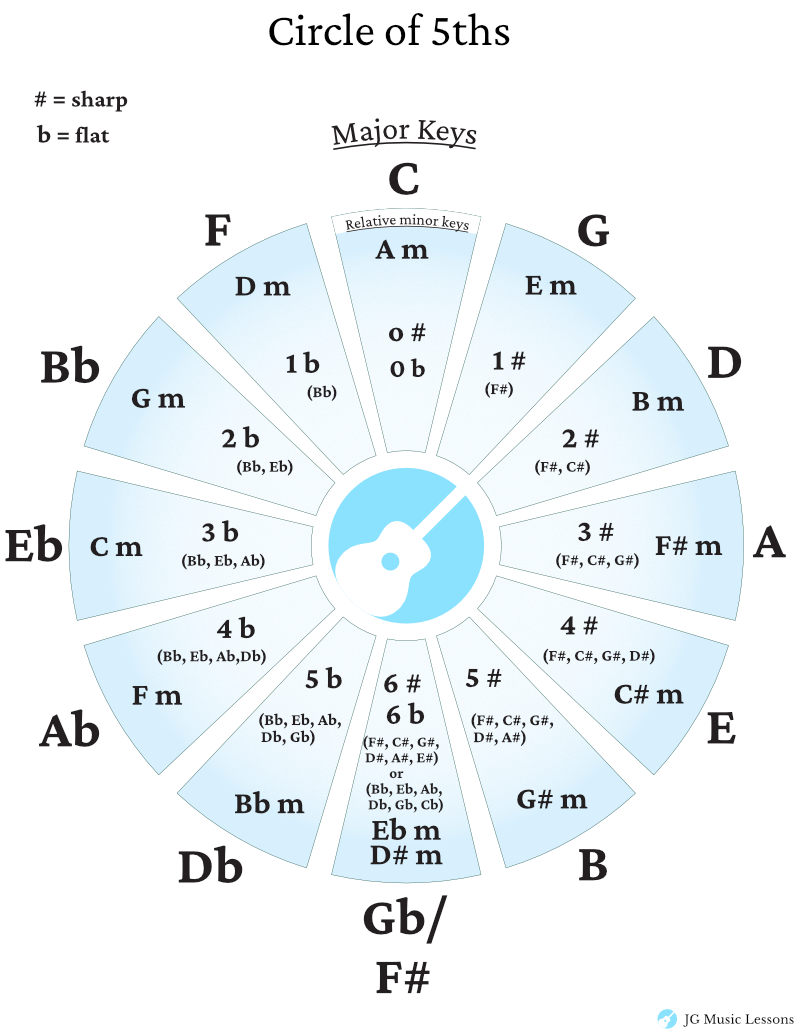

How to quickly find a key signature
There are two methods for quickly finding key signatures depending on whether they are keys with sharps or flats. These tips will help you quickly know what key a song is in.
Tip to quickly find a key with sharps
Whenever you see sharps in a key signature, a quick way to find what key you are in is to count a half step up from the last sharp. For example, if the last sharp in a key signature is C#, count a half step up and you get the note D. You would be in the key of D Major or the relative B minor.
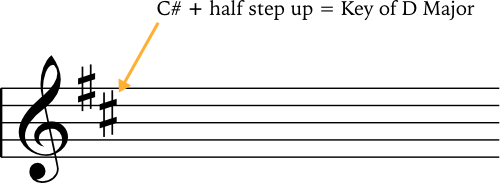
If the last sharp in a key signature is D#, count a half step up and you are in the key of E.
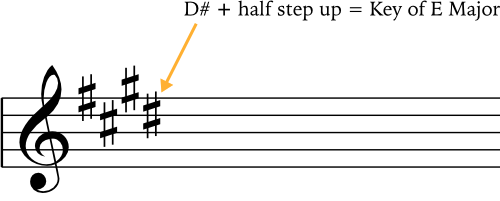
Tip to quickly find a key with flats
Whenever you see flats in a key signature, a quick way to find what key you are in is to look at the note in the second to last flat. The only exception for this is for the key of F which starts with one flat (Bb).
For example, if you have 3 flats in the key signature (Bb, Eb, Ab), count one before the last flat and you get the key of Eb Major.
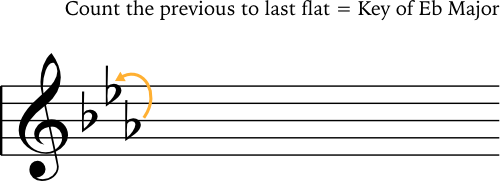
Or if you have 5 flats in the key signature (Bb, Eb, Ab, Db, Gb), if you count one before the last flat and you get the key of Db Major.
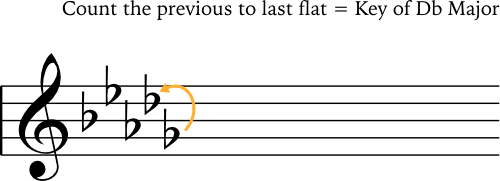
Major and minor scale formulas
Although learning key signatures are great for helping know the right notes of a scale, another way to think about scales is by using a formula for the distance between notes.
For example, every Major scale follows this same formula of whole steps and half steps: whole, whole, half, then whole, whole, whole, half.
Take a look at how to apply this formula to different Major scales below.

And for minor scales, the formula for steps between each note is whole, half, whole, then whole, half, whole, whole.
See the formula application to minor scales below.
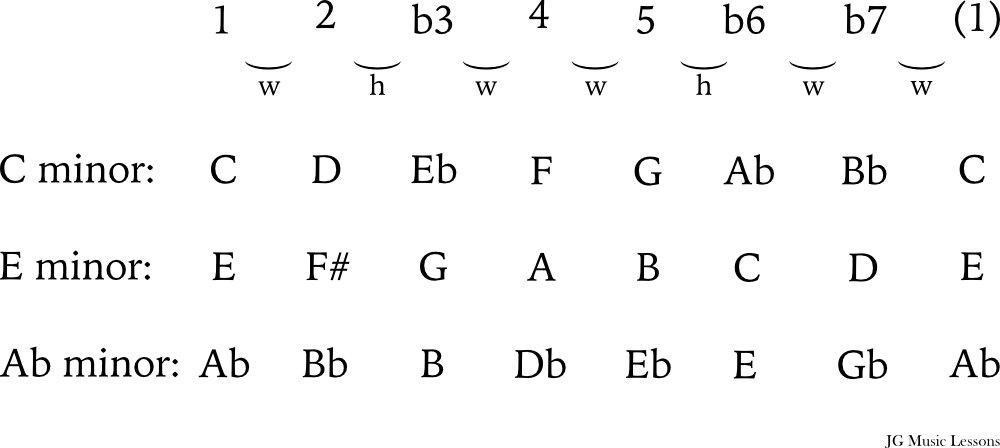
Want to test your music theory skills? Take this quiz to find out.
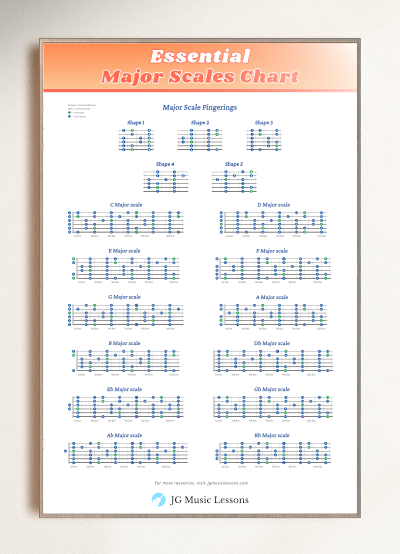
Wrapping up
In this lesson, we covered what key signatures are and how they are used in music notation. We also looked at how to use the circle of 5ths to understand how many accidentals each key contains.
It’s helpful to try memorizing each key signature so that you know the right notes to play scales or when composing music.
You may also want to check out the guide on time signatures to learn about another other essential music symbol.
📘 Get the free guitar practice guide here!
Best,
JG Music Lessons
Start Playing Better, Faster
with Pro Membership! ✨
Get the guidance, tools, and support that keep your progress on track:
🏁 Always know what to practice next. Access the full Guitar Learning Roadmap with lessons in sequence.
🎼 Play songs with confidence. Step-by-step lessons of popular, classical pieces and other styles.
📙 Save time and frustration. Clear PDFs and ebooks that save time so you can focus on playing.
🎟️ Get rewarded for consistency. 2 free downloads every month (a $240+ yearly value).
🎁 Keep costs low while you grow. 50% off all charts, tracks, and posters — up to 75% off bundles.
🚫 Stay focused. Ad-free environment keeps you in the zone.
💬 Get help when you need it. Direct member support to keep you on track.

